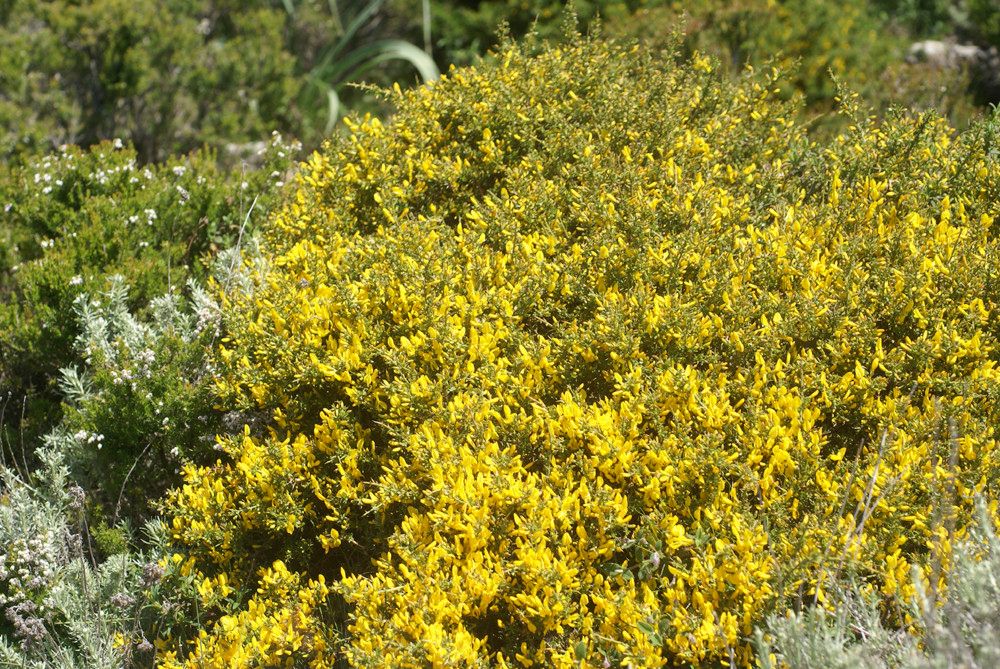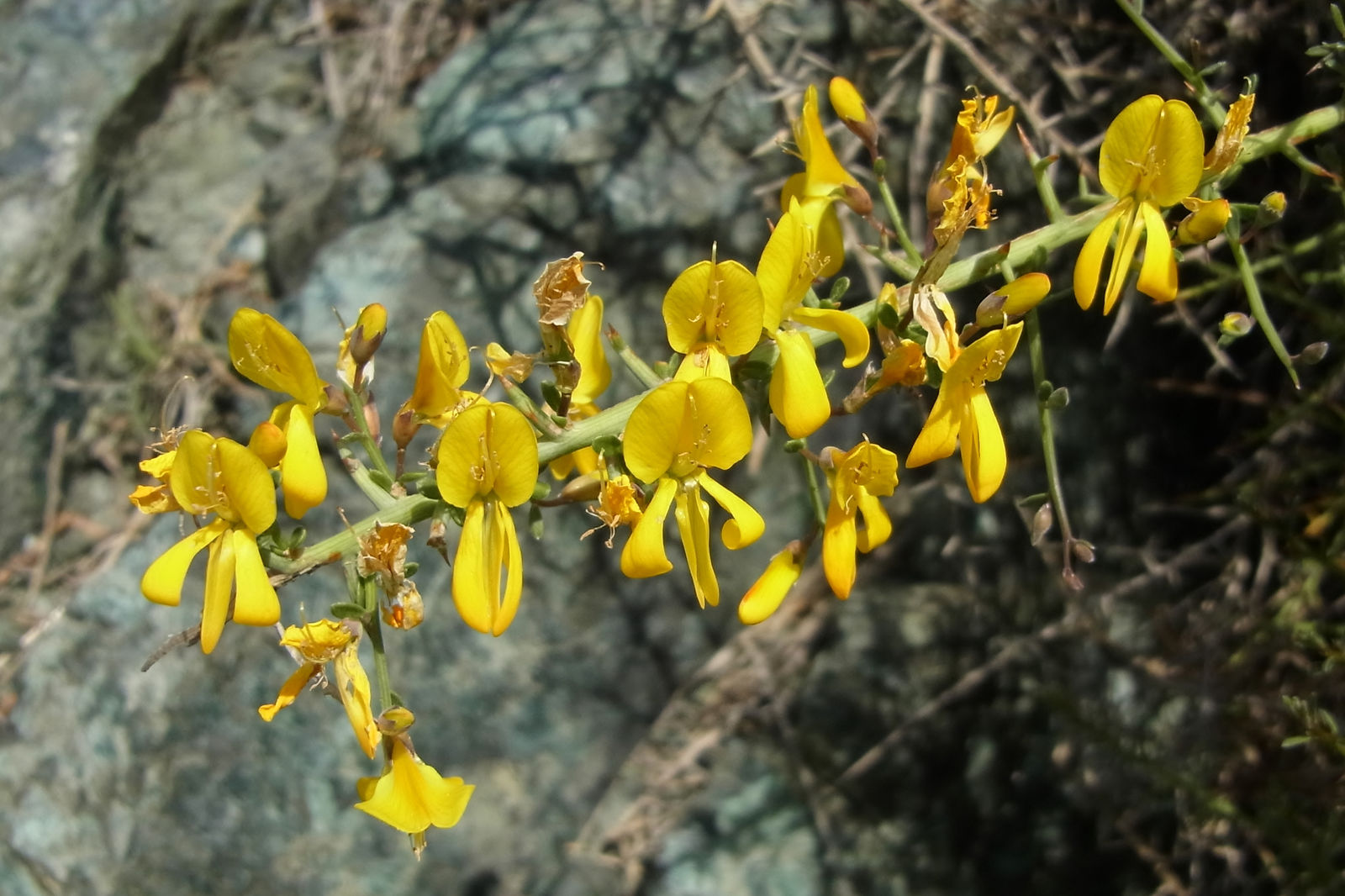Corsican Broom
genista corsica
Also known as: ["Corsican Broom","Island Broom"]
Overview
A deciduous shrub native to Corsica, known for its bright yellow flowers and hardy nature.
Benefits & Perks
["long-flowering","deer resistant","wildlife attractant (bees, butterflies, birds)","drought tolerant","seasonal color change"]
Botanical Classification
| Phylum: | Magnoliophyta |
| Class: | Magnoliopsida |
| Order: | Fabales |
| Family: | Fabaceae |
| Genus: | Genista |
| Botanical Name: | Genista corsica |
Plant Characteristics
Basic Information
- Category: Shrubs
- Suitable Location: outdoor garden bed in a sunny, sheltered spot
- Suitable For:
- Is Weed: No
- Allergenicity: low
Environmental Needs
- Climate: {"temperatureRange":"5–30°C"}
- Hardiness: {"zones":"7–9"}
- Misting: rarely required, only if grown indoors in very dry conditions
- Drainage: Fast-draining to prevent root rot.
- Soil Type: Well-draining, sandy, or loamy soil with some organic matter.
Maintenance Level
- Maintenance Level: moderate
- Toughness Level: high
- Pruning Frequency: Annually, after flowering in late spring or early summer.
- Pruning Intensity: Moderate; remove up to one-third of old growth to rejuvenate the plant.
Care Details
Ideal Sunlight Coverage:
Full sun (6–8 hours of direct sunlight daily). Adjust for intense summer sun by providing partial afternoon shade.
Sunlight Tolerance Tips:
Acclimate gradually if moving from shade to full sun. Protect from harsh midday sun to prevent scorching. Outdoor placement is ideal for full sun exposure.
Care Requirements
Care Difficulty
moderatemoderate
Sunlight
full sun
Full sun lover; protect from intense afternoon sun; rotate for even growth.
Watering
every 7–10 days during active growth, less frequently in winter
Water deeply but infrequently; avoid overwatering; ensure excellent drainage.
Soil
well-drained, sandy or loamy soil
pH: Slightly acidic to neutral (pH 6.0–7.0).
Ensure excellent drainage; avoid heavy clay soils; amend with sand or perlite.
Temperature
Hardy to USDA zones 7–9. Prefers mild temperatures (50–75°F or 10–24°C). Tolerates mild frosts but avoid prolonged freezing.
Protect from frost; avoid extreme heat; maintain moderate temperatures.
Fertilizing
every 4–6 weeks during spring and summer
Fertilize once a year in spring; avoid nitrogen-rich fertilizers; do not fertilize in winter.
Propagation
Methods
Stem cuttings taken in late spring or early summer.
Step-by-Step Propagation Guide
- Take 4–6 inch cuttings.
- Remove lower leaves.
- Dip in rooting hormone.
- Plant in medium.
- Keep moist and humid.
Best Time: Late spring to early summer when new growth is firm but not woody.
Environment
Warm (65–75°F or 18–24°C), high humidity (70–80%), and bright indirect light.
Medium
Well-draining mix of perlite and peat moss or cactus mix.
Hormone
Rooting hormone is recommended to improve success rates.
Timeline
Roots develop in 4–8 weeks; establish in new pot after 3–6 months.
Tools Needed
Pruning shears, rooting hormone, small pots, misting spray bottle.
Quick Tips
Use non-flowering stems; maintain humidity with a plastic cover; keep out of direct sun.
Pruning & Repotting
Pruning Guide
Method
Selective thinning and heading back to shape the plant and improve air circulation.
Pruning Plan
Prune to maintain shape, encourage bushiness, and remove dead or weak growth.
Tools
Pruning shears, loppers (for larger branches), gloves.
Checklist
Sterilize tools; prune after flowering; remove dead/damaged wood; shape lightly.
Repotting Guide
Best Season
Early spring before new growth begins.
Pot Size
Move to a pot one size larger (1–2 inches wider in diameter).
Method
Use fresh, well-draining soil; trim roots if necessary; ensure good drainage; water lightly after repotting.
Suggestions
Repot only when root-bound or every 2–3 years to refresh soil.
Checklist
Check root-bound status; use fresh soil; trim roots if needed; water lightly; place in shade for recovery.
Advanced Care Tips
Watering Mastery
Watering Checklist
Check soil moisture before watering; water deeply; ensure drainage; reduce winter watering.
How to Apply Water Properly
Water at the base of the plant, targeting the root zone. Ensure water penetrates deeply but does not pool. Water in the morning to allow foliage to dry.
Watering Schedule Tips
Water sparingly, allowing soil to dry out completely between waterings. Reduce watering significantly in winter to prevent root rot.
Soil Improvement
Add perlite or coarse sand to improve drainage; incorporate compost for fertility.
Temperature Stress Management
Signs of Temperature Issues
Chlorosis, leaf drop, stunted growth, or browning leaf edges.
Cold Stress
Leaves may wilt or turn yellow; growth slows or halts; risk of root damage in freezing conditions.
Solution: Mulch heavily in winter; protect from cold winds; move potted plants to a sheltered location.
Hot Stress
Wilting, leaf scorch, reduced flowering, or leaf drop due to excessive heat and dryness.
Solution: Provide afternoon shade; increase humidity; water deeply and mulch to retain moisture.
Fertilizing Guide
Fertilizing Checklist
Use balanced fertilizer; apply in spring; avoid over-fertilizing; skip winter feeding.
Fertilizing Method
Use a balanced, slow-release fertilizer in early spring. Avoid over-fertilizing, as Genista corsica is not heavy feeder. Dilute liquid fertilizer to half-strength if used.
Common Problems & Solutions
Toxicity Warning
Cats
Slightly ToxicCats may experience mild gastrointestinal symptoms if they consume the seeds or berries of Genista corsica. The toxic effects are generally not severe but can cause discomfort.
⚠️ Symptoms:
🌿 Toxic Parts:
⚡ Toxic If:
if eaten
Dogs
Slightly ToxicIn dogs, ingestion of Genista corsica seeds and berries can lead to mild gastrointestinal upset. The toxic compounds primarily affect the digestive tract.
⚠️ Symptoms:
🌿 Toxic Parts:
⚡ Toxic If:
if eaten
Humans
Slightly ToxicGenista corsica contains toxic compounds that can cause mild gastrointestinal distress and other mild symptoms upon ingestion. The physiological impact is generally limited to the digestive system.
⚠️ Symptoms:
🌿 Toxic Parts:
⚡ Toxic If:
if eaten
Frequently Asked Questions
Q: Is Genista corsica toxic to pets?
A: Yes, it is toxic to both dogs and cats.
Q: Does Genista corsica attract wildlife?
A: Yes, it attracts bees, butterflies, and birds with its flowers.
Q: How drought-tolerant is Genista corsica?
A: It is highly drought-tolerant once established.
Quick Reference
| Family: | Fabaceae |
| Care: | moderate |
| Light: | full sun |
| Water: | every 7–10 days during activ |
Get Expert Care Tips
Download the Plantious app for personalized care reminders and plant identification!
Google Play App Store







